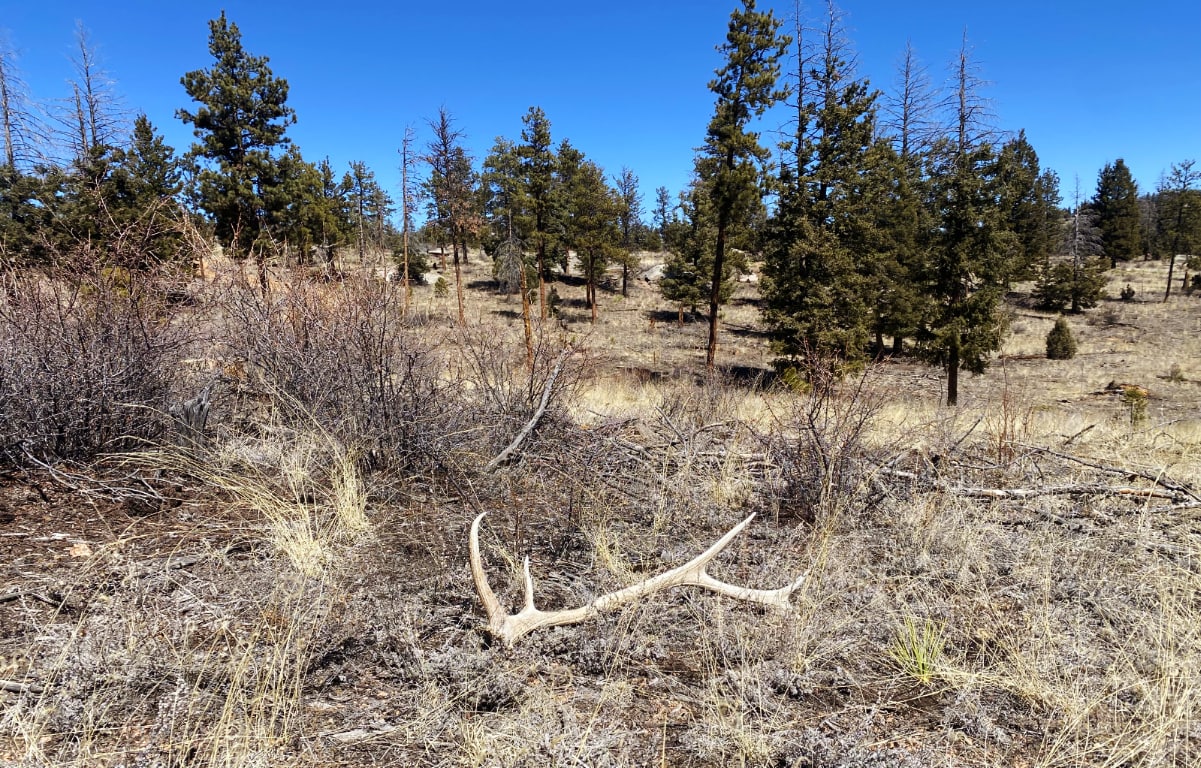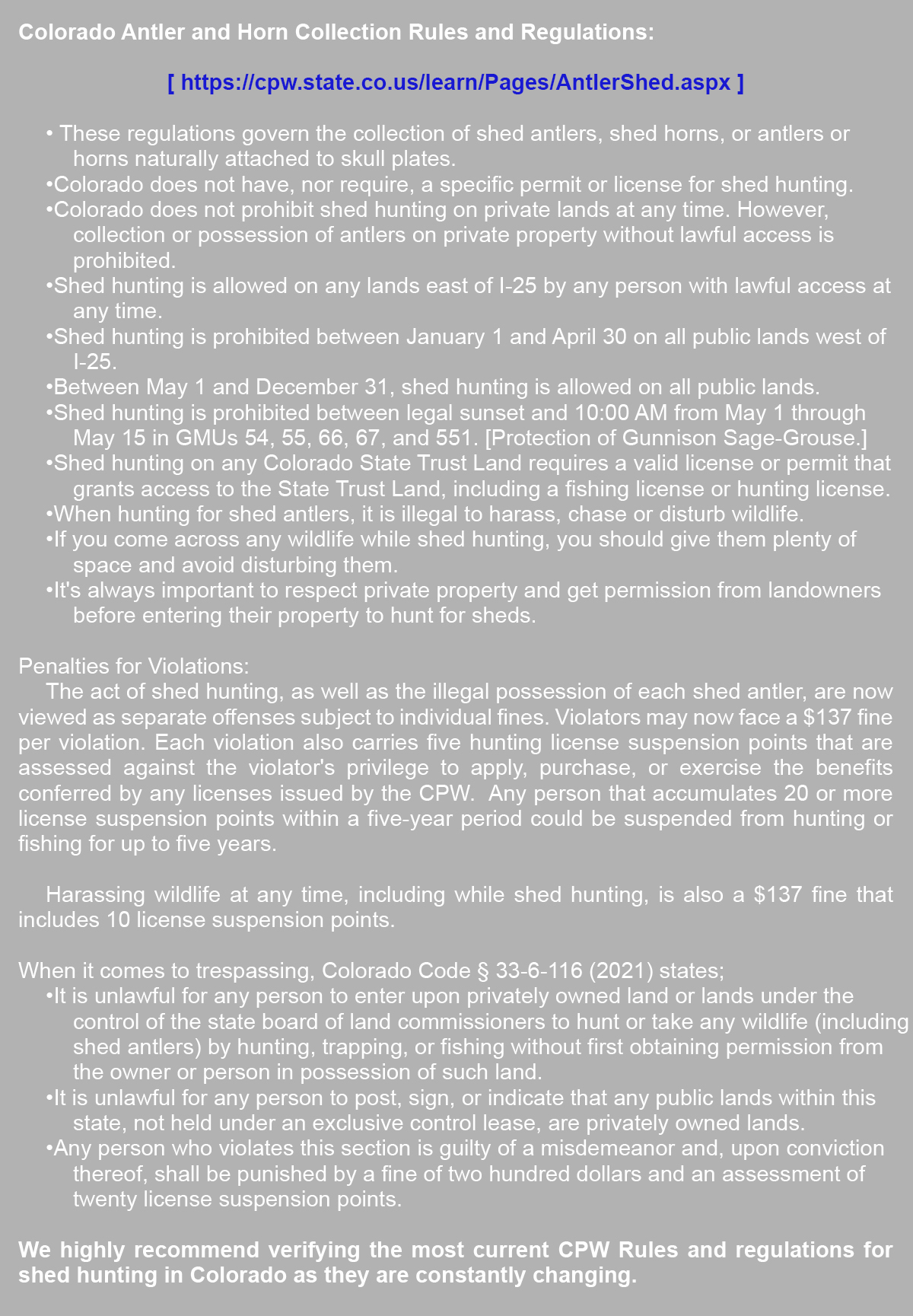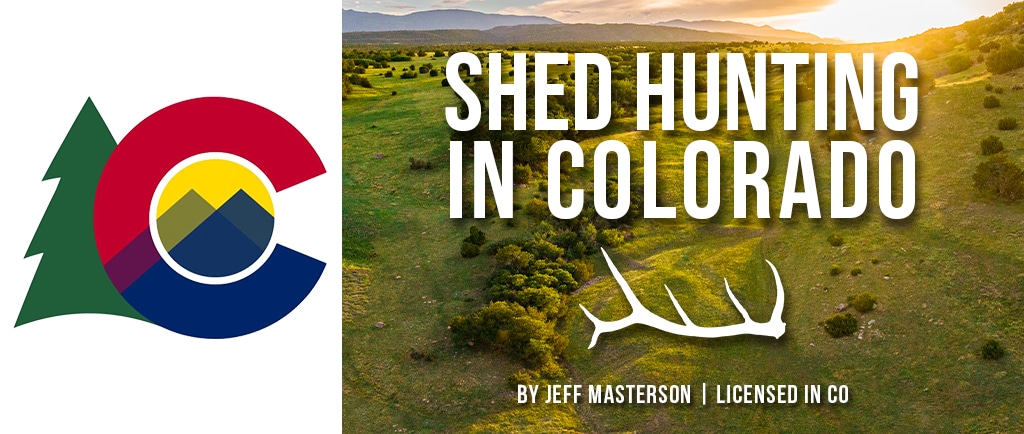Colorado is home to one of the largest Elk and Mule Deer populations in the world, and shed hunting for their antlers has become increasingly popular. The rules and regulations governing the collection of antlers are increasing as well, and changing. In this article we’ll explore the current rules and regulations, and also explain some techniques that will make it more enjoyable and successful.
[BLOG: SHED HUNTNG CLOSURES IN WESTERN STATES]
When it comes to locating sheds, Colorado’s vast and rugged terrain provides endless opportunities for shed antler hunters to explore and discover hidden treasures. From high alpine ridges to sagebrush-covered valleys, there are countless areas throughout the state that can yield great finds for those willing to put in the effort. Whether you’re a seasoned shed hunter or just starting out, here are some top areas to consider when searching for shed antlers in Colorado.
Winter Range: The winter range is an area where Elk and Mule Deer spend most of the winter, and it can be a good place to find shed antlers. Elk often gather in large numbers on winter ranges, which increases the chances of finding shed antlers. You can locate estimated Winter Range areas using the CPW Hunting Atlas. [https://ndismaps.nrel.colostate.edu/index.html?app=HuntingAtlas].
Migration Routes: Elk and Mule Deer typically migrate from higher elevations to lower elevations during the winter months, and they often follow specific routes. These migration routes can be a good place to search for shed antlers, as Elk and Mule Deer may drop their antlers during the journey. You can locate estimated Migration Routes using the CPW Hunting Atlas listed above.

Feeding and Watering Areas: Elk and Mule Deer will often concentrate in areas with abundant food and water during the winter months when they drop their antlers. Look for areas with natural feed sources such as meadows, brushy areas, and aspen groves.
Bedding Areas: Sheltered areas with cover, such as dense stands of conifers or on protected sides of ridges, can be good places to search for shed antlers, as Elk and Mule Deer may drop their antlers when they stand up from their beds.
Trails and Fences: Well-defined trails and fence lines are often used by Elk and Mule Deer as travel corridors. These areas can be good places to search for shed antlers, as they may drop their antlers while traveling.
South-facing Slopes: South-facing slopes receive more sunlight and can provide better forage for during the winter. Elk and Mule Deer tend to concentrate on these slopes and may drop their antlers while feeding.
Antler Dislodging Areas: Elk and Mule Deer going through thick vegetation or jumping over fences can cause the antlers to become dislodged.
Successful Areas: Return to areas where you have found a high concentration of sheds in the past. Elk and Mule Deer often shed their antlers in the same general location each year.
Finding shed antlers takes patience and persistence, and the best approach is to cover as much ground as possible while keeping an eye out for antlers. It’s also important to respect wildlife and their habitat and avoid disturbing them during the search.

Shed hunting requires many of the same skills and equipment as traditional hunting. You may have to navigate through rugged terrain, covering large distances, spending long hours in the field, and be able to spot and identify antlers from a distance. Therefore, much like actual hunting, proper gear and equipment can help aid in the successes in the field while shed hunting. Additionally, many hunters enjoy shed hunting to stay connected to the outdoors, maintain their hunting skills, and test new gear.
Several useful tools while shed hunting include:
Binoculars: Binoculars with a high field of view and magnification power like Zeiss’ Conquest HD 10×56 can help you spot antlers from a distance.
GPS device: A GPS or mapping App on your phone can help you navigate unfamiliar terrain and mark the locations of antlers that you find.
Backpack: A backpack with lots of accessory straps and that is comfortable with a heavy load is essential for carrying around big antlers.
Hiking poles: Hiking poles can provide additional stability and support while navigating rough or steep terrain.
Headlamp or flashlight: A headlamp or flashlight can help you navigate in low-light conditions and find your way back to your vehicle after dark.
Antler dogs: Trained dogs can be used to locate shed antlers and they can be a valuable asset for shed hunters.
First Aid Kit: Whenever you are exploring the great outdoors, it is always good to have a first aid kid on hand.
Personal Protection: A firearm or bear mace is always a good tool to carry while exploring the backcountry of Colorado.
Although not necessary, using gear that is similar to that used in traditional hunting, shed hunters can be better prepared for the challenges of shed hunting and increase their chances of success along with having a more enjoyable experience searching for antlers in Colorado.
Including kids while shed hunting is a great way to get them outdoors and build memories. Shed hunting doesn’t require being quiet, nor moving silently, so shed hunting is a fantastic activity for kids. Bring plenty of water and snacks, and ensure they have enough clothes to keep them warm. Give them small tasks like navigating to a nearby tree or carrying the snack bag so they have a task they are responsible for and are engaged during the trip. Letting them find the shed (even if you spot it first) will give them a great memory from the field; and take time to celebrate that with them. And don’t forget to take plenty of pictures with them!
In conclusion, shed hunting is a unique and rewarding outdoor activity that requires a combination of skills, knowledge, and equipment. By following the rules and regulations, understating the habits of Elk and Mule Deer, using proper gear, and prioritizing safety, shed hunters can have a successful and enjoyable experience while exploring the wild places of Colorado. Shed hunting not only provides an opportunity to find antlers and connect with nature but can also be a valuable way to develop and maintain hunting skills during the off-season. With respect for wildlife and the environment, shed hunting can be a fulfilling and sustainable outdoor pursuit.

Jeff Masterson is a Broker Associate in Colorado, he can be reached via email [jeff@sjsportingproperties.com] and phone [303-847-7351]




